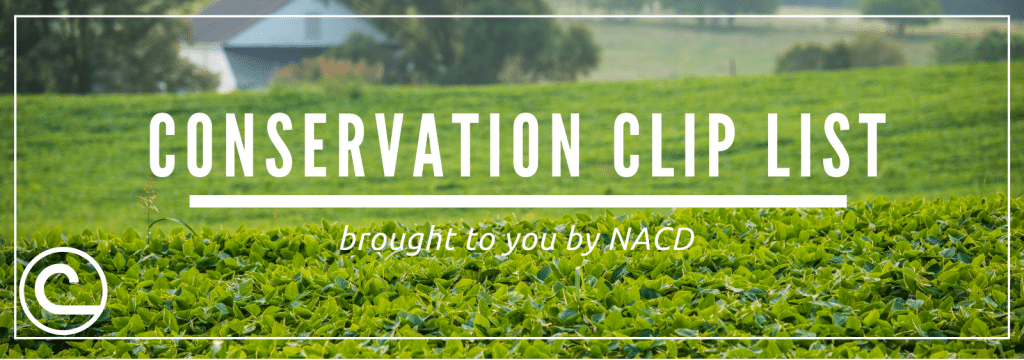
Conservation Clips is a weekly collection of articles distributed by NACD that provides our members and partners with the latest news in what’s driving conservation. These articles are not indicative of NACD policy and are the opinions of their authors, unless otherwise noted. If you have a relevant submission or need assistance with accessing articles, please contact the NACD Communications Team.
StarTribune: Evolving Pheasants Forever increases birds, habitat, while helping corporations reach sustainability goals
By Dennis Anderson
10/09/21
Together with Michelle French, director of global sustainability programs at Archers Daniels Midland Co.; Margaret Henry, director of sustainable agriculture at PepsiCo; and Jeremy Peters, CEO of the National Association of Conservation Districts, Bue, among other board members, works collaboratively to serve food, conservation and related interests.
Agri-Pulse: Ag’s climate funding at stake as Dems debate cuts to spending plan
By Philip Brasher
10/13/21
(Subscriber Only) Other groups that signed the letter included the National Sustainable Agriculture Coalition and National Association of Conservation Districts as well as the Environmental Working Group, National Audubon Society, National Wildlife Federation, Natural Resources Defense Council, Sierra Club, Union of Concerned Scientists and World Wildlife Fund.
USDA-FSA: USDA Launches First Phase of Soil Carbon Monitoring Efforts through Conservation Reserve Program Initiative
10/12/21
The U.S. Department of Agriculture (USDA) is investing $10 million in a new initiative to sample, measure, and monitor soil carbon on Conservation Reserve Program (CRP) acres to better quantify the climate outcomes of the program.
The Crescent-News: Transitioning to improved soil health
10/09/21
Improving soil health starts with evaluating your soil and then fixing those problems. Fall is an excellent time to evaluate your current soil health and to start making management changes for next year.
Bay Journal: $10 million awarded for Bay conservation work
By Karl Blankenship
10/13/21
Efforts that will plant forest buffers along streams, remove barriers to fish migration, engage underserved communities and accelerate nutrient reduction efforts in the Chesapeake Bay region were among 49 projects that received more than $10 million in grants on Tuesday.
Successful Farming: PERENNIALS WITH PURPOSE
By Megan Schilling
10/11/21
“Since planting prairie on my terraces, I haven’t had a problem with erosion and now, there is wildlife galore. When I take people on a tour of the strips, I have to slow down so I don’t knock over a bunch of monarchs.”
Morning AgClips: National network working on new varieties of cover crops
10/13/21
A Cornell University-led national network of scientists and farmers is developing new varieties of cover crops that are better adapted to local regions and stressors – changes that could carry a bevy of long-term and sustainable benefits for organic growers.
South Dakota State University: Intensively managed grazing can increase profits, improve environment
By Christie Delfanian
10/07/21
“By intensively managing grazing, producers can make money converting marginally productive cropland back to grassland, while at the same time reducing agriculture’s impact on the environment,” said South Dakota State University associate professor Tong Wang.
USDA: USDA Announces Plan to Integrate Climate Adaptation Into its Missions and Programs
10/07/21
The U.S. Department of Agriculture (USDA) released its climate adaptation and resilience plan describing how USDA will prepare for current and future impacts of climate change.
Herald-Whig: Cover crop can reduce waterhemp in soybean
By Deborah Gertz Husar
10/10/21
Cereal rye as a cover crop may reduce waterhemp populations without yield loss in soybean.
Los Angeles Times: As drought worsens, California farmers are being paid not to grow crops
By Ian James
10/10/21
The farmers are paid to leave a portion of their lands dry and fallow, and the water saved over the next three years is expected to translate into three feet of additional water in Lake Mead, which has declined to its lowest levels since it was filled in the 1930s following the construction of Hoover Dam.
ABC7: Cover crop season set to begin in Arkansas
10/11/21
The proper use of cover crops can produce several benefits for production systems in Arkansas including improved soil health, increased nitrogen, and additional weed control options, according to research done by the Arkansas Agricultural Experiment Station.
The Guardian: Lake Tahoe water level hits four-year low as drought pummels tourist spot
By Dani Anguiano
10/13/21
“It’s a sign of change at the lake,” Schladow said. “Change is very difficult to manage … When we start seeing things we’ve never experienced before at a greater frequency, it’s challenging.”
USDA-FSA: USDA Invests $4.7 Million to Provide Outreach and Technical Assistance to Historically Underserved Farmers and Ranchers
10/07/21
The U.S. Department of Agriculture (USDA) announced an investment of $4.7 million to establish partnerships with organizations to provide outreach and technical assistance to historically underserved farmers and ranchers.
The Transylvania Times: U.S. Senators Tillis, Burr Support Wildlife Conservation Bill
10/13/21
U.S. Senators Thom Tillis and Richard Burr are co-sponsoring the most significant wildlife conservation bill in nearly half a century, the Recovering America’s Wildlife Act (RAWA), according to a N.C. Wildlife Resources Commission news release.
Science Daily: Scientists can switch on plants’ response to light
10/06/21
Scientists have figured out how plants respond to light and can flip this genetic switch to encourage food growth, even in shade. The discovery could help increase food supply for an expanding population with shrinking opportunities for farming.